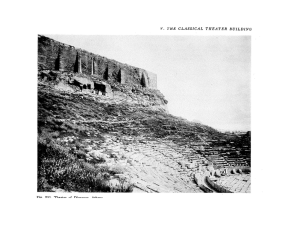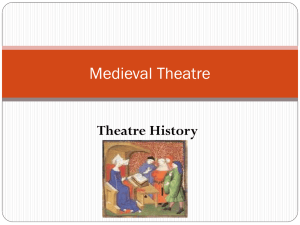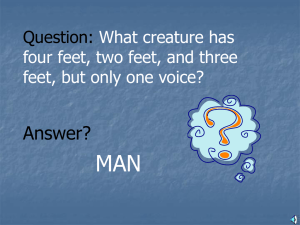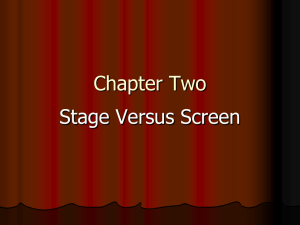The Theatre of Asia
advertisement
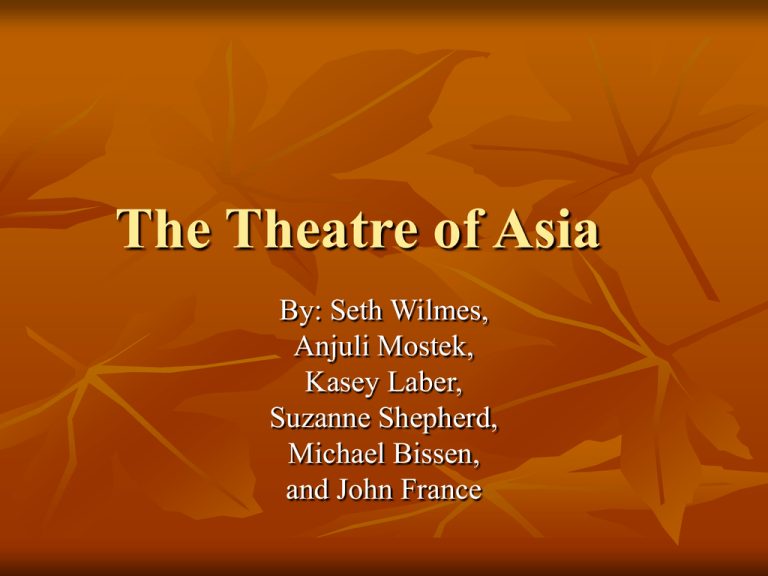
The Theatre of Asia By: Seth Wilmes, Anjuli Mostek, Kasey Laber, Suzanne Shepherd, Michael Bissen, and John France Theatre of Asia 3 Main Sections India China Japan The Drama of India Started from the Middle East Roots Based on Greek Texts Sanskrit Dance-Theatre Sanskrit dance theatre was achieved around 200 B.C and remained popular The Natyasastra is the most comprehensive study of theatre from the ancient world Two primary genres of Sanskrit Theatre Praka- based on theme of love Nataka- based on well-known heroic stories of kings or sages Sanskrit Dance-Theatre Continued This theatre was performed indoors within a roofed building that was rectangular 4 Columns hold the roof or an upper pavilion up Sanskrit drama died out around the tenth century. Kathakali The most widely known dance-drama Kathakali means story play The audience could leave anytime, eat, or even sleep during the performance Actors had to train from early childhood because it is so difficult Based on two Indian epics Ramayana Mahabharata Drama of China Chinese Opera: Xiqu China = oldest home of Asia’s oldest continuous theatre tradition. Provides common metaphors for daily life Proverb wentai jiaphua = we learn our real world behaviors from stage performance. Xiqu’s Origins Zaju (“various plays” – in China during Song Dynasty Zaju = comedic music-dance-drama; acrobatics and clowning By 1644 Zaju succeeded by kunqu Kunqu Still preformed today. “Clapper Opera” Staging of Xiqu Xiqu is sceneryless, and presented in a wide variety of surroundings Usually outdoors : parks, restaraunts etc. Audience is free to talk & eat (very laid back) Staging cont’d Plays are almost always anonymous Based on well known stories from Chinese history or myth. All plays include both serious and comic elements Staging cont’d Serious and Comic not tragedy and comedy Instead… Civil plays (wenxi)=love, marriage, and domestic justice Martial plays (wuxi)=battles, banditry, and armed rebellions. Staging cont’d A second terminology seperates them into… Great plays (daxi) Small plays (xiaoxi) Determines the degree of seriousness in the dramatic treatment Staging cont’d All actors are proficient in: Individual skills (gong) Singing (chong) Speech (nian) Acting and Movement (zuo) Martial Arts and Acrobatics (da) Staging cont’d Parts are played by a person who is special only at the one part desired A person may spend their whole life only doing one thing in every play Types of roles: Male (sheng) Female (dan) Staging cont’d Roles of male and female broke down even more Male roles (sheng): Old man (lao sheng) Young man (xiao sheng) Warrior (wu sheng) Painted face ( always a man) (Jing) Staging cont’d Female Roles: Quiet and Gentle (quing yi) Vivacious and dissolute ( hua dan) Old women (lao dan) Warrior Princess (wu dan) Clown characters (male or female) – white painted face (chou) Staging cont’d Costuming is according to time honored conventions Actors both sexes wear multilayered robes patterned with multi-bold colors Some even wear headresses Staging cont’d What certain colors mean: Bright yellow = emperors Apricot = foreign rulers White = generals Bronze and bean paste = old officals Theatre in Asia Indian, Chinese, and Japanese drama are the most noticed in Western Theatre Never spoken, but danced, chanted, mimed, and sung More concerned with performing arts than dialogue Dance, song, mime, gesture, acrobatics, puppetry, music, sound, costume, and makeup Chinese Opera: Xiqu Sung more than spoken Xiqu means tuneful-theatre We translate it as Chinese Opera Xiqu’s Origins Zaju- “various plays” Xiqu’s Origins Zaju- “various plays” First form appeared in Song dynasty Comedic music-dance-drama Kunqu Appeared in Ming dynasty Poetic and aristocratic opera Xiqu’s Origins “Clapper Opera” Characterized by rhythmic beating of drumsticks on a hardwood block Jingju a.k.a. Beijing Opera Most famous today Singing, music, and acrobatics and martial arts Staging of Xiqu First, performed outdoors, on temporary stages Later moved into tea gardens and restaurants Today it is in international–style Chinese theatre Informal Free to talk, eat, and move during perfomances Staging of Xiqu Based on well-known stories from Chinese history or myth Actors must be proficient in Singing, speech, acting , and movement, and martial arts and acrobatics Theatre in Japan Two Main Theatre Forms Nō Kabuki Nō Japans most revered and cerebral theatre Oldest continuously performed drama in world Almost always portrays supernatural events and characters Nō characters: Shite All plays focus on a single character Shite (doer) Shite is usually gods, ghosts, women, animals, or warriors Shite character always has a mask Nō characters: Waki Waki character also used Waki is a secondary character Interrogates, prompts, and challenges shite Always represents a living male Usually ministers, commoners, or priests Nō actors Always male Train for only one role type Normally perform this role for their career Nō stage Highly polished Japanese cypress flooring Earthenware jugs supporting floor resonate with foot stompings Hashigakari – bridgelike runway providing access to stage right, characteristic of style Ornate, curved roof covers stage Nō overall Never been a mass entertainment, mostly produced for enthusiasts In Japan however, number of Nō supporters growing Remains a national pastime Sublime mystery and serenity is reflective of Buddhist and Shinto values Kabuki Created during the Edo Era Themes consisted of conflicts of humanity and the feudalistic system Kabuki Origins/History Invented by Izumo Okuni around 1600 Started as an all women ensemble In 1629 the Government banned women from the stage because the behavior was against morals Catamites (boy prostitutes) were hired to play the roles Kabuki Origins/History Cont. In 1652 the government outlawed the boy performers as well Adult males became the leads in the plays Still all male ensemble to this day Kabuki became more sober and dramatic as a result Kabuki Plays Most fall into 3 categories History plays (jidaimono) Domestic plays (sewamono) Dramatize political events Deal with affairs of townspeople, merchants or lovers Dance dramas (shosagoto) Among most popular deal with spirits and animals Kabuki Theatres Kabuki-za theatre in Tokyo Minami-za theatre in Kyoto Shinkabuki-za theatre in Osaka Kabuki Scenery Stage sets 2 or 3 stories high Revolving stages Rolling stage wagons provide 3-D background Kabuki Music Music room called the Geza Orchestra Chief instrument is samisen banjo like 3-string instrument Almost always continuous music and sound effects from the Geza Kabuki Actor Training Train for much of life Actors work up from small parts to larger ones People say actor doesn’t develop Kabuki face until their 50’s




